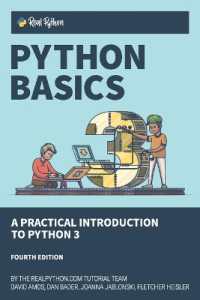- ホーム
- > 洋書
- > 英文書
- > Science / Mathematics
基本説明
Presents the four most important approaches to the imaging of biological structures: crystallography, non-crystallographic diffraction, optical microscopy, and electron microscopy.
Full Description
Knowledge of the microscopic structure of biological systems is the key to understanding their physiological properties. Most of what we now know about this subject has been generated by techniques that produce images of the materials of interest, one way or another, and there is every reason to believe that the impact of these techniques on the biological sciences will be every bit as important in the future as they are today. Thus the 21st century biologist needs to understand how microscopic imaging techniques work, as it is likely that sooner or later he or she will have to use one or another of them, or will otherwise become dependent on the information that they provide.
The objective of this textbook is to introduce its readers to the many techniques now available for imaging biological materials, e.g. crystallography, optical microscopy and electron microscopy, at a level that will enable them to use them effectively to do research. Since all of these experimental methods are best understood in terms of Fourier transformations, this book explains the relevant concepts from this branch of mathematics, and then illustrates their elegance and power by applying them to each of the techniques presented.
The book is derived from a one-term course in structural biology that the author gave for many years at Yale. It is intended for students interested either in doing structural research themselves, or in exploiting structural information produced by others. Over the years, the course was taken successfully by advanced undergraduates and by graduate students. Scientists interested in entering the structural biology field later in their careers may also find it useful.
Contents
Part 1. Fundamental Concepts. ; 1. On the Scattering of Electromagnetic Radiation by Atoms and Molecules. ; 2. Molecular Scattering and the Fourier Transform. ; 3. Scattering by Condensed Phases: a More Sophisticated Look at Atomic and Molecular Scattering. ; Appendix 3.3: Energy absorption and the imaginary part of ?. ; Part 2. Crystallography. ; 4. On the Diffraction of X-rays by Crystals. ; 5. On the Appearance of Crystalline Diffraction Patterns. ; 6. Solving the Phase Problem. ; 7. Electron Density Maps and Molecular Structures. ; Part 3. Non-Crystallographic Diffraction. ; 8. Diffraction from Non-Crystalline Samples. ; Part 4. Optical Microscopy. ; 9. Image Formation Using Lenses. ; 10. The Light Microscope. ; Part 5. Electron Microscopy. ; 11. Lenses that Focus Electrons. ; 12. Image Formation in the Electron Microscope. ; 13. Electron Microscopy in Three Dimensions. ; Appendix 13.1: Solving least squares problems. ; Appendix 13.2: Error propagation in linear systems. ; Appendix 13.3: The Fourier transform in cylindrical coordinates.








